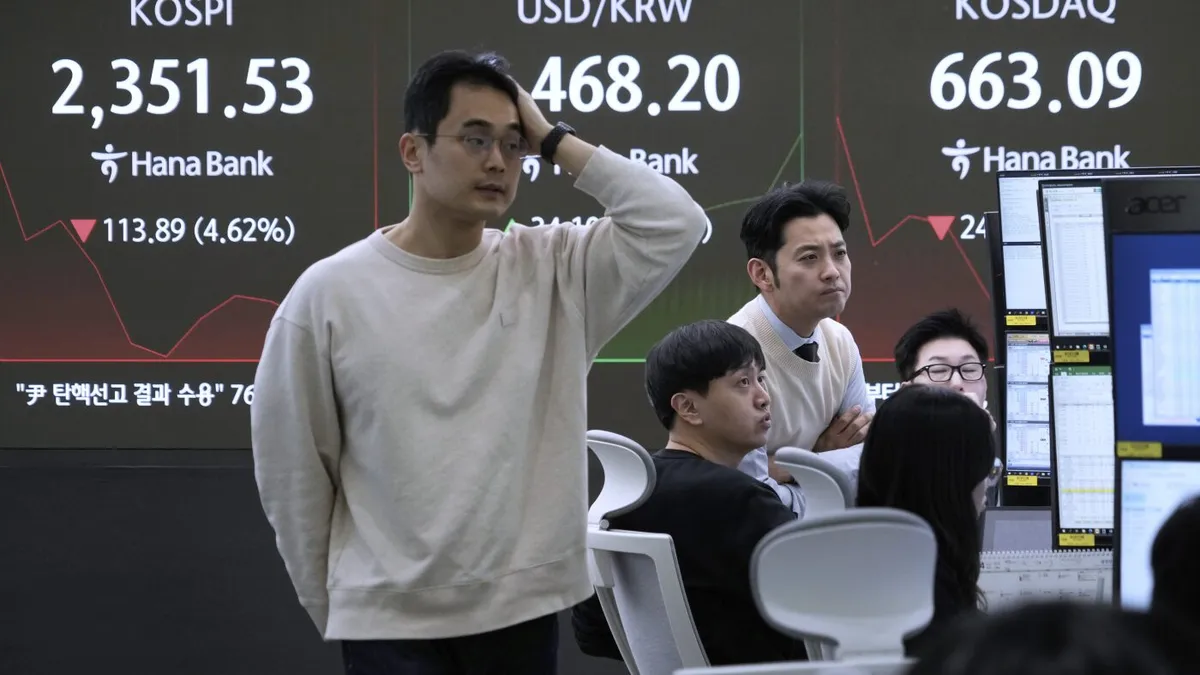
BANGKOK — Asian shares experienced a dramatic decline on Monday, following a significant downturn on Wall Street over the weekend. The sell-off was largely triggered by U.S. President Donald Trump's announcement of increased tariffs, which prompted a swift and aggressive response from Beijing. As a result, U.S. futures indicated further weaknesses, with the S&P 500 futures down by 2.5%, the Dow Jones Industrial Average futures shedding 2.1%, and the Nasdaq futures plunging by 3.1%.
Tokyo's Nikkei 225 index opened to a staggering loss of nearly 8% and was down 6% by midday, trading at 31,758.28. This significant drop led to a brief suspension of trading for Topix futures due to a circuit breaker being triggered after a steep fall in U.S. futures. Notably, Mizuho Financial Group's shares plummeted by 11.3%, while Mitsubishi UFJ Financial Group's stock fell by 9.9%, as investors reacted with panic over the potential impacts of the escalating trade war on the global economy.
Although Chinese markets usually diverge from global trends, they too witnessed significant declines. Hong Kong’s Hang Seng index dropped 9.4% to 20,703.30, and the Shanghai Composite index fell by 6.2% to 3,134.98. Major tech firms also suffered, with e-commerce giant Alibaba Group Holdings seeing a 10% decrease and Tencent Holdings losing 9.4%.
In the commodities market, oil prices continued to slide, with U.S. benchmark crude falling 4%, or $2.50, to $59.49 per barrel. The international standard, Brent crude, also saw a decrease of $2.25, bringing it down to $63.33 a barrel. These declines come amid rising concerns about how the trade conflict will affect global demand for oil.
In currency trading, the U.S. dollar weakened against the Japanese yen, dropping to 146.70 yen from 146.94 yen. The yen is often viewed as a safe haven during periods of market turmoil. The euro also experienced a slight decline, slipping to $1.0926 from $1.0962, reflecting broader market anxieties.
Friday marked Wall Street's most severe crisis since the onset of the COVID-19 pandemic, as the S&P 500 tumbled 6%, the Dow fell by 5.5%, and the Nasdaq composite decreased by 5.8%. Market analysts anticipate that investors will encounter more volatility in the upcoming weeks, with a resolution to the trade war seeming increasingly unlikely. Nathan Thooft, chief investment officer at Manulife Investment Management, highlighted that multiple countries may retaliate against the U.S. tariffs, potentially prolonging market uncertainty and volatility.
The escalating trade war reached a critical point as China matched Trump's hefty tariff increase, raising fears of a global recession. The U.S. job market showed signs of strength with a better-than-expected report, but this news was not sufficient to halt the market's downward trajectory. The Commerce Ministry in Beijing announced it would impose a 34% tariff on all U.S. imports starting April 10, as a direct response to the U.S. tariffs.
With the U.S. and China being the world's two largest economies, the potential for a trade war-induced global recession looms large. Currently, the S&P 500 is down 17.4% from its February record. President Trump acknowledged that while tariffs might cause short-term pain for Americans, the long-term goal of revitalizing U.S. manufacturing jobs justifies the current measures. Meanwhile, the Federal Reserve faces a dilemma; although it could lower interest rates to mitigate tariff impacts, Chairman Jerome Powell cautioned that this might stoke inflationary pressures.
Despite the turmoil, some analysts remain hopeful that Trump might reduce tariffs following negotiations with other countries. Stuart Kaiser, head of U.S. equity strategy at Citi, noted in a client memo that current earnings estimates do not fully account for the trade war's potential impacts, suggesting there is still significant downside risk. Meanwhile, White House trade adviser Peter Navarro urged investors not to panic, claiming that the administration's trade policies would ultimately lead to significant market growth.